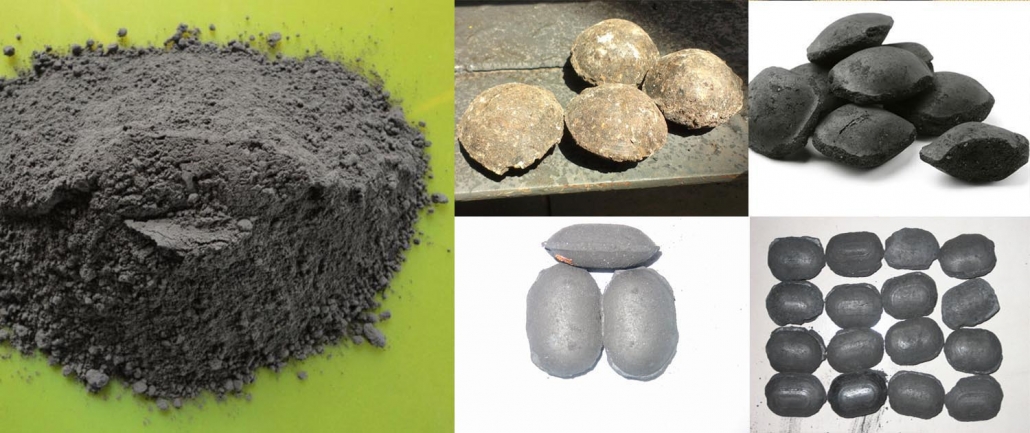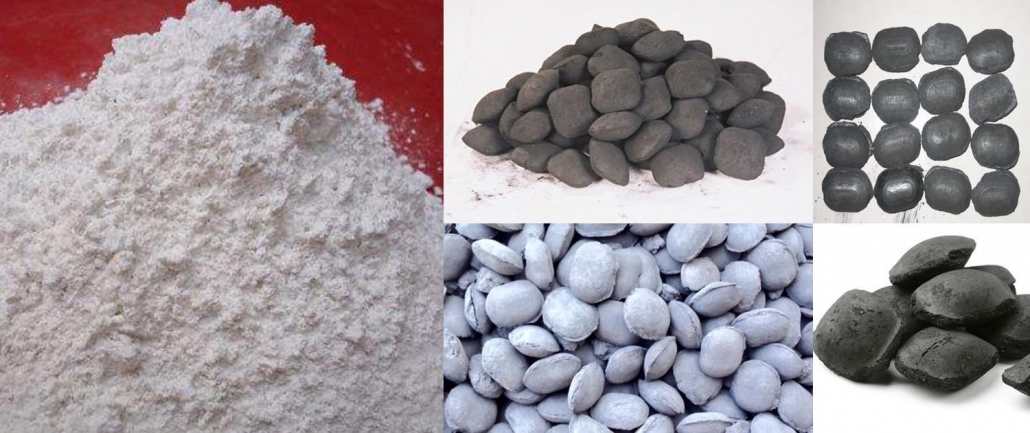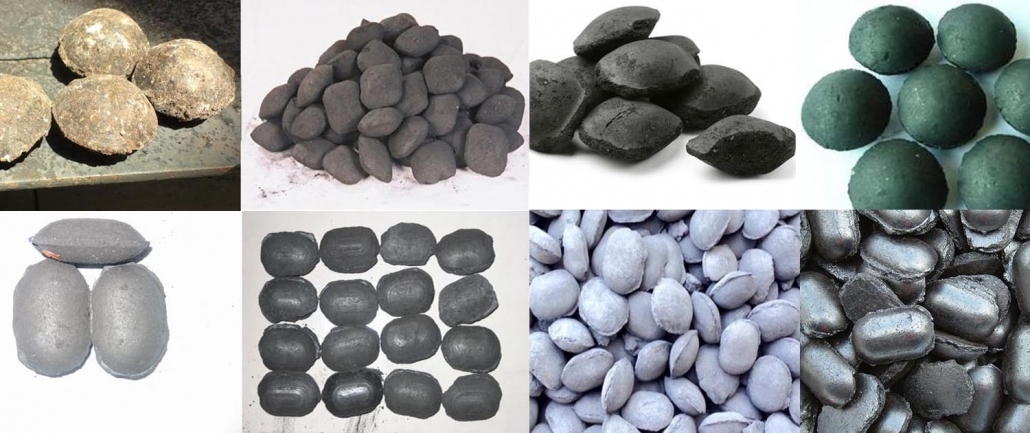

-
Products
-
Application


Briquette is made of pulverized coal as the main raw material, and is molded by mechanical processing according to the proportion, mechanical strength, and shape required by the specific application. The coal products with a certain strength, size and shape, common coal products include briquettes, briquettes, coal sticks, briquettes, etc.
As a kind of clean coal production technology, briquette production has the advantages of simple operation, mature technology, low cost, obvious energy saving and efficiency, and reduced exhaust gas emissions. The production process is divided into binder-free molding, binder molding, and thermal Three kinds of compression molding. There are many types of forming machines, such as stamping forming machines, roll forming machines, screw extruders and honeycomb coal machines.
There are many types of briquette. The briquette can be pulverized coal, coal noodles, coal slime, respectively pressed into spherical or other shapes. It is also possible to mix pulverized coal and slime into spherical and other shapes. Used for boiler combustion and gas production.
The powdered coal or pulverized coal is press-formed by a mechanical method, and the coal product has a certain shape or particle size. Common ones are briquettes, briquettes and briquettes. Briquette can improve combustion efficiency, reduce environmental pollution, expand the application range of lean coal, gas coal, long flame coal and lignite and other high volatile and weak caking coal, and rationally utilize coal resources.
There are two types of briquette for industrial use and civil use. Industrial briquette includes chemical briquette, which is used for chemical fertilizer production, steam locomotive briquette, and metallurgical briquette (also called briquette). Civil briquette, also known as domestic coal, is used for cooking and heating, mainly briquettes.

①The briquette used in chemical industry is generally 35-50mm briquettes, which can be formed with anthracite less than 3mm or powdered lignite with a tar yield greater than 10%. It is mainly used for producing gas from chemical fertilizers, producing semi-coke, liquid or gas fuel and producing chemical products such as methanol and acetic acid.
②The briquette used as fuel for steam locomotives has several shapes such as oval shape and drip shape. The coal for locomotives developed in China can save coal by more than 8%. The development of power briquette needs to solve the key technical issues such as using temperature control to master thermal deformation characteristics during the combustion process, using batching technology to improve coal quality, and increasing the ash melting point of briquette. For example, for coal with high sulfur content, catalytic reverse equilibrium should be used to increase the sulfur conversion rate to reduce pollution.
③Formed coke is formed by forming weakly cohesive pulverized coal and coking in a continuous coking oven, or using high-speed thermal analysis to extract colloids to achieve hot pressing into coke. The development of coke can expand coking raw materials and improve the efficiency of coke ovens. China uses low-pressure binder molding to produce industrial briquette. The binder is mostly lime, petroleum pitch, tar pitch or paper pulp waste liquid. The amount depends on the agglomeration of coal, generally 5-10%.
In addition to ordinary briquettes and briquettes, in recent years, the development of combustible briquettes for heating and upper-ignition briquettes for household cooking has begun. The structure and raw material formula of this briquette are more complicated. Generally consists of three parts: ignition layer, ignition layer and coal body. The ingredients of each layer are different in formula.
①The ignition layer is mostly mixed with oxidizer or paraffin wax, carbon, semi-coke powder and other combustible substances mixed with binder.
②The ignition point of the transition layer is slightly higher than that of the ignition layer, which can ignite fire. Therefore, the raw material coal is required to have a large calorific value of 6000kcal/kg and a suitable particle size.
③The coal body can adopt anthracite, bituminous coal, lignite, peat or flotation tailings according to local conditions. When the briquette made of bituminous coal burns, the volatile matter and the free carbon produced by pyrolysis are not fully burned and fumes. Therefore, the volatile matter of the ingredients must be controlled within the range of 20-25%, and an appropriate amount of coke and coke must be added. lime. Make the inside of the coal body have a good microporous structure, creating conditions for the uniform precipitation of combustible gas; it is also necessary to improve the stove to ensure sufficient oxygen supply to achieve complete combustion and smoke suppression. The briquettes with anthracite as the main body should be appropriately added with high volatile bituminous coal to enhance the flame temperature, height and ignition speed. If the ingredients are appropriate, the gas after the ignition of the briquettes can generally meet the environmental protection requirements, but the cost is slightly higher.

As the main body of civil briquette, briquette is equipped with advanced stoves, and its thermal efficiency is twice as high as that of burnt coal. Among various clean coal technologies, industrial coal has the highest energy conversion rate, reaching 97.5%, which is far greater than other technologies. Boiler briquette products have a large particle size, which can ensure the required gaps during combustion, and the combustion efficiency is high. At the same time, the amount of exposed coal is small. Compared with burning raw coal, it saves 15% to 20% of coal.
Boiler burning coal can greatly reduce air pollution. Compared with burning raw coal, SO2 emissions are reduced by about 40% to 60%, NO2 emissions are reduced by about 40%, soot emissions are reduced by about 60%, and strong carcinogens (Bap) are reduced by more than 50%, which has obvious environmental protection effects. The addition of sulfur-fixing agents and binders during the processing of briquette can reduce SO2 emissions by 40% to 50%, and at the same time can reduce solid dust emissions. In addition, briquette can use industrial waste and agricultural waste as a binder, turning waste into treasure, reducing the emissions of the three wastes.
In the process of briquette processing and manufacturing, through the use of additives, coals with different properties are combined and blended to obtain indicators such as cohesiveness index, ignition point, ash content, ash melting point, sulfur content, fixed carbon, volatile content, and calorific value The improvement has increased the reactivity, flammability and thermal stability of coal, increased the ash melting point, and produced high-quality products with various indicators meeting customer requirements. For example, through coal blending, non-coking coal can be made into molded coke as a substitute for metallurgical coke; bituminous coal can be made into anthracite briquette to replace gas-making anthracite lump coal, thereby expanding the utilization of coal.
A considerable part of China's industrial boilers and kilns are layer-fired and require lump coal; the production of synthetic gas and fuel gas in China's chemical fertilizer industry requires lump coal. The development of industrial briquette can alleviate the shortage of lump coal in short supply, and at the same time open up a technical way for the rational and effective use of fine coal.
Problems existing in burning industrial briquette in existing industrial boilers:
1. It is difficult to ignite the flame.
2. Stop the furnace to extinguish the fire.
3. The furnace temperature is low, the briquette burning time is long, the burning is not clean, and the carbon content in the ash is high.

Industrial briquette needs requirements:
1. It has sufficient cold mechanical strength;
2. Have sufficient thermal stability;
3. It has strong moisture resistance and waterproof performance;
4. It has strong frost resistance;
5. With natural fast curing performance;
6. Save energy;
7. Reduce environmental pollution;
8. Low cost and high quality.
When evaluating the quality of industrial briquette, in addition to industrial analysis and element analysis of briquette, the following characteristic indicators should be considered:
1. Mechanical strength: including cold (hot) mechanical strength, drop strength, drum strength, etc. At present, there is no unified national quality standard for industrial coal, only the national quality standard for gasification and boiler coal. In the early 1980s, the main assessment indicators for "industrial coal development" were: cold compressive strength 350~500N/ball, drop strength greater than 75%, and drum strength greater than 70%. In addition, the mechanical strength requirements recognized by most domestic coal briquette experts for gasification briquette are: cold compressive strength greater than 400/N ball, thermal compressive strength greater than 200N/ball, thermal stability greater than 75%, and drop strength greater than 80% , The quality requirements for fuel briquette such as boilers can also be relaxed.
2. Ash melting property: the ash melting property ST of coal briquette for gasification is greater than 1250℃.
3. Sulfur fixation performance: the sulfur fixation rate of industrial coal with added sulfur fixation agent should be greater than 45%.
4. Water resistance: evaluate the performance of briquette after being immersed in water.
In addition to industrial analysis and element analysis, civil briquette also includes:
1. Calorific value: It should be greater than 16.6~20.8MJ/kg, which varies in different regions.
2. Compressive strength of honeycomb coal end face: Ф102mm, greater than 600N/block; Ф127mm, greater than 700N/block.
3. Thermal stability: no furnace collapse, no plugging, no slagging, no bursting during combustion.
4. Heating speed: more than 1℃/min.
5. Firepower: greater than 15/min.
6. Thermal efficiency: greater than 40%.
7. Ash melting: greater than 1100℃.

Official Agent of ZY MINING in Russia.
Please enter here.
Add: Luoxin Industrial Zone,Luoyang City,Henan Province P.R.C.
Tel: +86-379-67313306
E-mail: gloria@zyksjx.com